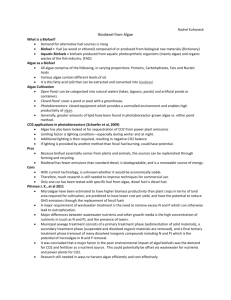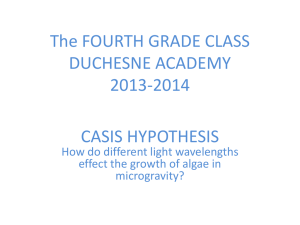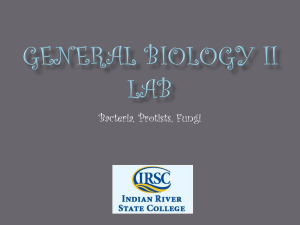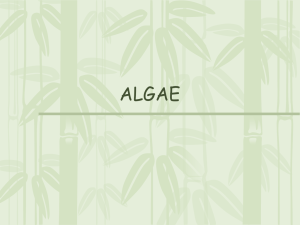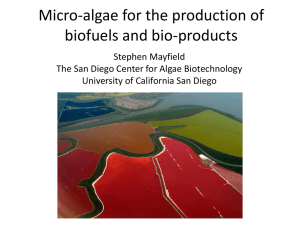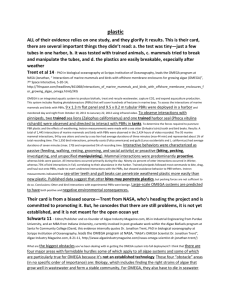1614-Biology Biofuels Lessons
advertisement
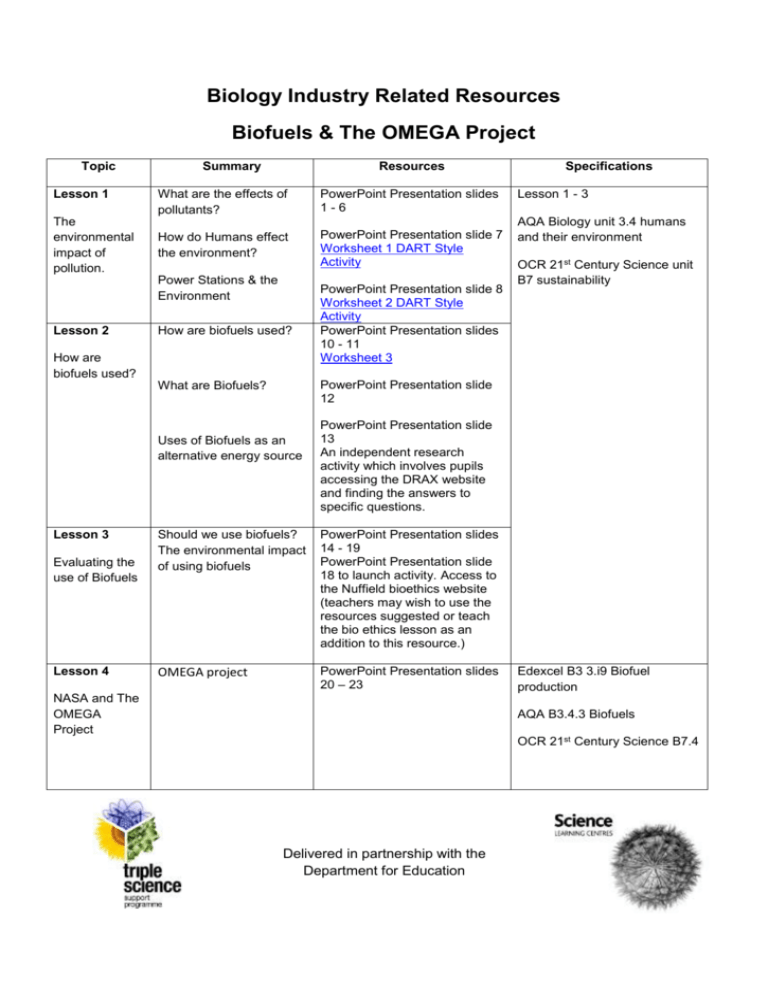
Biology Industry Related Resources Biofuels & The OMEGA Project Topic Lesson 1 The environmental impact of pollution. Summary Resources What are the effects of pollutants? PowerPoint Presentation slides 1-6 How do Humans effect the environment? PowerPoint Presentation slide 7 Worksheet 1 DART Style Activity Power Stations & the Environment Lesson 2 How are biofuels used? How are biofuels used? Uses of Biofuels as an alternative energy source Evaluating the use of Biofuels Lesson 4 Lesson 1 - 3 AQA Biology unit 3.4 humans and their environment OCR 21st Century Science unit B7 sustainability PowerPoint Presentation slide 12 What are Biofuels? Lesson 3 PowerPoint Presentation slide 8 Worksheet 2 DART Style Activity PowerPoint Presentation slides 10 - 11 Worksheet 3 Specifications PowerPoint Presentation slide 13 An independent research activity which involves pupils accessing the DRAX website and finding the answers to specific questions. Should we use biofuels? The environmental impact of using biofuels PowerPoint Presentation slides 14 - 19 PowerPoint Presentation slide 18 to launch activity. Access to the Nuffield bioethics website (teachers may wish to use the resources suggested or teach the bio ethics lesson as an addition to this resource.) OMEGA project PowerPoint Presentation slides 20 – 23 NASA and The OMEGA Project Edexcel B3 3.i9 Biofuel production AQA B3.4.3 Biofuels OCR 21st Century Science B7.4 Delivered in partnership with the Department for Education PowerPoint Presentation slides 25 – 30 Teachers Notes Algae as green plants Edexcel B1 3.26 demonstrate an understanding of how carbon is recycled AQA B 1.4.1 Adaptations Suggested investigations includes pond organisms 1.5.1 biomass B2.1.1 algal cell structure is specified B1.6.2 The carbon cycle OCR 21st Century Science B3 OMEGA project use of cleaned sewerage PowerPoint Presentation slide 24 Edexcel B1 3.27 demonstrate an understanding of how nitrogen is recycled AQA B2.3.1 g Nitrates B3.4.1 Waste from human activity OCR 21st Century Science B3.1 B7.4 Photosynthesis PowerPoint Presentation slide 30 Edexcel B2 2.16 Investigate how factors , including the effects of light intensity,CO2 concentration or temperature, affect the rate of photosynthesis AQA B2.3 photosynthesis 2.3.1 f Conversion of glucose to oil for storage. OCR 21st Century Science B4.2 Forward Osmosis PowerPoint Presentation slides 31 – 34 Teachers Notes Edexcel B2 2.21 investigate osmosis AQA B3.1.1 Delivered in partnership with the Department for Education Biofuels Lesson 1: What are the effects of biofuels? Worksheet 1 Since the 1920s the world’s population has increased from an estimated 2billion to an estimated 7billion in 2012. Since the 1920s the world has changed significantly, and a major driving force behind this was the industrial revolution. Since the revolution humans, particularly those in westernised countries, are demanding a convenient lifestyle including highly technological manufactured goods. Today’s lifestyle is one in which we must move forward faster while making life’s chores easier. The only way to meet these demands is to use the Earth’s natural resources such as fossil fuels, land and ores. There are many environmental impacts which are a consequence of meeting these demands such as: land pollution, water pollution, deforestation, and air pollution, and all of these contribute to global warming. Worksheet 2 Visit the following web page and explain how Drax Power Station impacts the environment. http://www.teachingzone.org/drax/teacher.htm (open up the using coal document) Discuss your findings with a partner. Think about the following questions: What do you think the problems with using coal are? How is the coal transported? What are the problems with this transportation? Would Drax have a large carbon footprint? Delivered in partnership with the Department for Education Worksheet 3 Delivered in partnership with the Department for Education The science of the OMEGA project Introduction This series of lessons is to encourage the exploration of the biological science behind the NASA OMEGA project. The OMEGA project is a piece of research that has led to the use of algae for production of bio fuels by using cleaned but nitrate-rich waste water. Part of the emphasis is on biology being a leading science in what is traditionally seen as a physical science and mechanical engineering heavy research base. The project is not only for production of bio fuel but can be seen as an example of phytoremediation of human impact as it uses waste nitrates and carbon dioxide. The materials are based around a PowerPoint that provides lesson starting points and internet links. There are a variety of links that can be made with the syllabi depending on which one is being used. I have used these materials to link in with the following areas: Classification Photosynthesis limiting factors Investigation planning and data logger use Development of biological ideas to engineering outcomes Osmosis and partially permeable membranes in cell structure Phytoremediation of human effects on the earth Algae as organisms Algae are fascinating organisms in their own right. The development of life as we know it depended on their transformation of the early earth’s atmosphere. If you have time, pupils can perform a web research activity on algae and their role in ecosystems, natural carbon dioxide sequestration, formation of oil and uses in modern products. The wide range of alginate uses is particularly interesting, especially when pupils realise they have eaten or used them in products ranging from ice cream to make up. Delivered in partnership with the Department for Education Algae in food webs Algae are the main producers in aquatic and marine food webs. Pond dipping allows observation of a range of these organisms. There are links for identification on the power point. If your pond sample does not seem particularly algae heavy, leaving it in a warm room with a few drops of Baby Bio added should help them along after a few days. This algal bloom can lead to a discussion on eutrophication. Lesson Objectives As a result of this lesson, students will be able to: (1) Identify common plants and animals living in an aquatic environment. (2) Create a food web illustrating the relationship of organisms in an aquatic habitat. (3) Understand the importance of algae and their response to environmental change. Although most algae are not pathogenic, other pond organisms may be, so good hygiene needs to be maintained in these activities. Limiting factors for algal growth Investigation Objectives As a result of this investigation, students will be able to: (1) Recognise and explain factors that affect plant growth (2) Plan an investigation to test some of these variables (3) Carry out experimental work with microbial cultures. Algae can be grown without particularly specialised equipment. There are a number of species that are commonly used in research. Chlorella is one that is being investigated for its oil content. I found it tricky to grow and the colony failed quickly. If you do wish to look further, a starter culture is available from biological suppliers. We use Blades as a supplier - http://www.blades-bio.co.uk/ Chlamydemonas is a much more robust alga and the one we are currently using. This organism has been widely used for over 20 years. There is interesting research Delivered in partnership with the Department for Education on producing hydrogen from it, since chlamydemonas is mixotrophic and can metabolise energy stores it has built up when starved of light and sulphur. This is why many algae can survive long periods of darkness. If you intend long term maintenance of your cultures you will need to use the correct growth media and very good sterile technique. For advice on this go to the “Chlamydemonas connection” at http://www.chlamy.org/ For short term investigations, it is enough to maintain a fair level of sterile technique, using wine equipment sterilizer or 70% alcohol for pieces that cannot withstand high temperatures. Also, use a more simple growth medium: 5 ml of miracle grow in 2lt of dechlorinated water will give a good starting medium. Baby Bio can also be used, as can fertilisers specifically designed for phytoplankton in aquaria. In the long term Miracle Grow is rather high in copper for aquatic use but this should not be a problem in the lab. To dechlorinate the water you can pass it through a carbon filter and leave for a couple of days, use a pond water conditioner or use distilled water. Once you have used the cultures they need to be disposed of safely. They can be killed by heating or put on a compost heap. Just avoid introducing large quantities of live culture into a local environment. They will make very good food for brine shrimp although they do not tolerate salt well in their growth medium. For growing your culture, you will need a transparent glass or plastic container. You can use conical flasks, or we use plastic drinks bottles to save on glassware. Chlamydemonas are motile and will also tend to clump together. You can agitate them or use a bubble tube, which has the added advantage of delivering a controlled air supply. Use an aquarium pump to deliver air. You can run several tubes from one pump if you use T tube junctions. The tubing used is standard clear plastic tubing. The tubing needs to end near the bottom of the flask to deliver aeration. You can use cotton wool as a bung, but foam bungs are available from suppliers and have the added advantage of neat removal and being able to withstand an autoclave. You can also make delivery holes in the plastic lids if you are using these. Air will need to be able to escape but microbes from the air should be excluded as much as possible. The air entering the system can be “washed” by passing it through a strong salt solution as it leaves the pump. This may initially scrub some of the carbon dioxide but it will soon be saturated. You can use other disinfectants, but check that they are not volatile or they will continue through the system. This initial chamber is made from a conical flask with a two hole solid bung. The incoming air is delivered under water and the output is well above the liquid level. This chamber could also serve as Delivered in partnership with the Department for Education a carbon dioxide scrubbing device, if you use lime water. Be aware however, that setting up conditions that could potentially produce hydrogen is fairly hazardous. This should not occur, provided the cells have an adequate supply of sulphur and carbon dioxide. The cultures will grow with a standard fluorescent lamp or a wide spectrum plant or daylight bulb. Do not expose them to very bright direct sunlight as they can be sensitive to ultra violet. They respond best to a 16 hour on, 8 hour off light cycle which enables them to synchronise their breeding cycle. To measure light intensity we use a standard light meter and data logger. Light colour is changed with gel filters. Temperature can be maintained in water baths if wished; although they do best at around 25oC they can tolerate up to the around 35oC. To measure cell growth, you can use a variety of techniques. If you decide to let the experiment run and take a final measurement, you can filter the algae, dry them, then weigh them. You can take samples and count cells under a microscope or you can use the light meters to give an indication of culture density. Use a light at a distance set to give a standard reading just below the meter maximum, and then place either the whole culture chamber or a sample into a smaller tube in front of the light sensor. It may well be possible to set up a continuous sampling with a light meter but Chlamydemonas tend to swim around and give some problems with this. Modelling the OMEGA system We have not got as far as setting up cultures in visking tubing although that will be a next step. Standard visking tubing in school labs has larger pores than the NASA nanopore plastic. If the system is to work it will not be in salt water and the nutrient supply will probably have to be in the surrounding liquid as well as the tube. Alternatively it may be possible to purchase the smaller pore material. Modelling the forward osmosis bag Activity Objectives As a result of this activity, students will be able to: Delivered in partnership with the Department for Education (1) Understand what is meant by forward osmosis. (2) Describe its use in a technological artefact. (3) Compare this to a biological system. This is the classic osmosis through visking tubing experiment given a twist by being used to model a piece of NASA kit as well as a cell membrane. The starch iodine complex will give a large blue molecule that will not pass through. Once it is set up it takes a few hours to fill. Other discussions and objectives This set of activities arose out of a consideration of solutions for human habitation in an artificial biosphere. It is particularly interesting to me since I used Chlamydemonas in my degree project 30 years ago when algae were recognised as having potential but not studied with such intense interest. Many advances in polymer chemistry have had to be made to make the sized pores as well as advanced understanding of the biochemistry of the algae. There is a lot of research being carried out into the potential of genetic modification of these microbes to make them more efficient. The debate over land use and competition for food supply by bio fuel manufacture is a discussion point that comes out of these materials as is the removal of carbon dioxide from the atmosphere and cleaning up nitrates. The OMEGA project could be seen as contained eutrophication. The precautions to avoid algal blooms by using freshwater algae can lead to a discussion on the environmental impact of introduced species or intensive farming. When discussing the project Jonathan Trent quoted Marshall McLuhan: “We have to remember, we are not passengers on spaceship Earth; we are the crew.” Perhaps considering the needs of an artificial biosphere can help us to respect our own. Useful references Including those on the power point Delivered in partnership with the Department for Education http://www.youtube.com/watch?v=c7Goyg12Reg&feature=related a link directly to the OMEGA project at NASA http://www.aquaticmanagement.com/algae.html a link to a site with algae identification http://www.youtube.com/watch?v=KuPMR_vMNR0 link to YouTube for NASA water recycling http://www.youtube.com/watch?v=a1pGsJMCyaI a rather long video demonstrating the forward osmosis bag http://www.concord.org/~btinker/workbench_web/models/osmosis.swf a link to an interactive demo of osmosis across a cell membrane http://www.aquaticmanagement.com/algae.html a link to a site with algae identification http://www.chlamy.org/ http://nutmeg.easternet.edu/~adams/chlamyTeach/ sources for growing media etc www.oilgae.com about oil from algae http://spacebiosciences.arc.nasa.gov/ Delivered in partnership with the Department for Education



